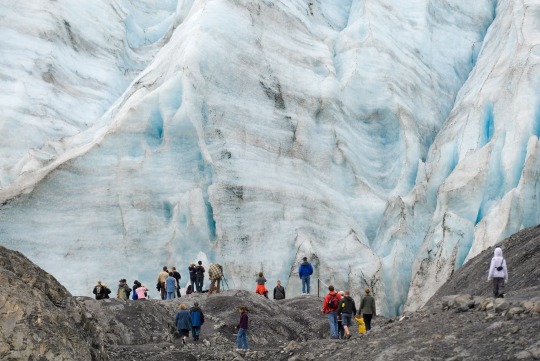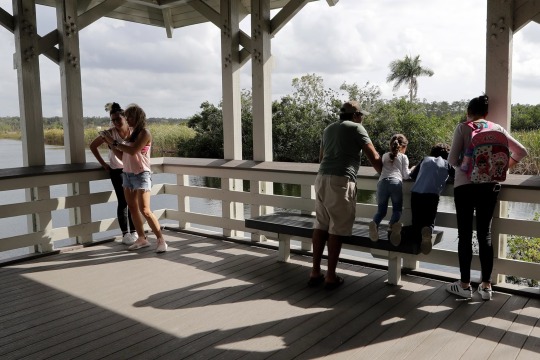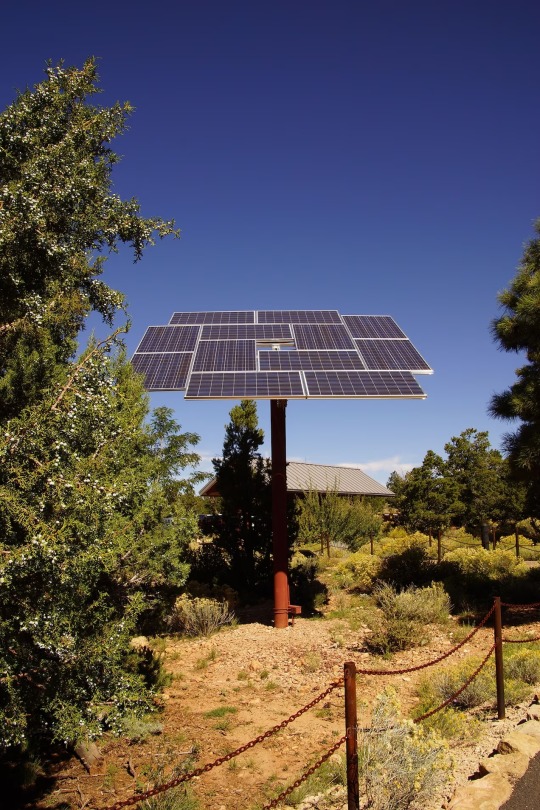#Carbon-Neutral
Text

2 notes
·
View notes
Text
A carbon-neutral synthesis of kerosene, or jet fuel, has been produced by scientists, made by combining sunlight with water.
5% of human emissions are generated through kerosene use in aviation, which currently has no alternative for long haul jetting.
It consists of 169 sun-tracking reflective panels that redirect and concentrate solar radiation into a solar reactor on top of a tower built at IMDEA Energy Institute in Madrid back in 2017.
The concentrated solar energy then drives oxidation-reduction (redox) reaction cycles in the solar reactor, in which a porous structure converts water and carbon dioxide injected into the reactor into syngas, which is made of hydrogen and carbon monoxide.
The syngas is then sent into a gas-to-liquid converter where it is finally processed into liquid hydrocarbon fuels that include kerosene and diesel.
The fuel will be even greener if the team can capture carbon dioxide from the air in the not-too-distant future and use it in the fuel.
#I was hesitant about posting this one but apparently it's legit#carbon-neutral#kerosene#solar energy#hydrocarbon#solar reactor#jet fuel#technology#oh brave new world
3 notes
·
View notes
Text

An abandoned building in the historic mining town of Ashford, Colorado, serves as the backdrop for stargazing. Hosted by the National Park Service, dark sky events are one way to help preserve public parks. Photograph By Babak Tafreshi, National Geographic Image Collection
Some U.S. National Parks Are Trying To Go Carbon-Free. What Does That Mean For Visitors?
U.S. National Parks are more climate-forward than ever. Discover ways you can support their mission.
— By Jacquiline Kehoe | August 4, 2023
Visiting at night and taking free public transportation are just two of the ways the National Park Service is encouraging visitors to go green.
In the early 2000s, NPS set out to address its environmental impact head-on. The first Green Parks Plan sought to answer big-picture questions: How can our national parks become Carbon-Neutral? Where do park emissions come from? Who or what accounts for the parks’ sizable carbon footprint?
Time and again, the answer? Visitors.
At Great Smoky Mountains National Park, guest transportation emissions—the park’s main greenhouse-gas offender—were 157 times greater than park operations. At Everglades, vehicle and watercraft use by travelers accounted for 86 percent of mobile combustion, the largest emissions-producing sector.
The NPS is now on its third iteration of the Green Parks Plan, released in early 2023. It’s the most robust version yet—goals include reducing greenhouse gas emissions to near zero, eliminating landfill waste, and investing in renewable energy. But the facts haven’t changed: these fragile landscapes need more from us.
“It’s essential to recognize that the national parks belong to the people and that people have an impact on our natural resources,” says NPS spokesperson Dave Barak. Without visitor support, in-park sustainability measures can only go so far. Working together, says Barak, “will allow NPS far more success in preserving and safeguarding these natural treasures than we could ever achieve without [visitor] support.”
Of course, most national parks seem purpose-built for a great American road trip. But that’s slowly changing. At the national parks below, exciting climate initiatives are afoot. All you have to do to help is skip the rental car.
Great Smoky Mountains National Park Lake Superior parks
In January 2023, the National Parks of Lake Superior Foundation announced that all five park units on America’s largest lake—the fastest-warming lake in the world—will go carbon-free. Isle Royale National Park, Pictured Rocks National Lakeshore, Keweenaw National Historical Park, Grand Portage National Monument, and Apostle Islands National Lakeshore are transitioning to electric equipment and transport, investing in solar and battery energy storage systems (BESS), and retrofitting all buildings to energy-efficient standards.
Great Smoky Mountains National Park—routinely the most visited national park in the country—has a vision problem. Thanks to human-caused pollution from within and around the area, such as burning fossil fuels, overflowing parking lots, and traffic jams, those famed “smoky” views are now smoggy. This haze has reduced the park’s visibility from 93 miles to 25 miles.
To tackle the issue, the park has paired with seven local shuttle companies to reduce congestion.
From Gatlinburg, Bryson City, and several other cities in Tennessee and North Carolina surrounding the wilderness area, visitors can book round-trip transfers to popular spots like Alum Cave Trail, Laurel Falls Trail, and Clingmans Dome, without worrying about parking and idling in traffic. Some providers also offer services to Pisgah, Nantahala, and Cherokee national forests for further adventures.

Great Smoky Mountains National Park, revenue from parking tags sold via solar-powered vending machines (pictured) go toward improving the park’s trails, custodial services, and education. Photograph By Carolyn Franks/Alamy
Lake Superior Parks
In January 2023, the National Parks of Lake Superior Foundation announced that all five park units on America’s largest lake—the fastest-warming lake in the world—will go carbon-free. Isle Royale National Park, Pictured Rocks National Lakeshore, Keweenaw National Historical Park, Grand Portage National Monument, and Apostle Islands National Lakeshore are transitioning to electric equipment and transport, investing in solar and battery energy storage systems (BESS), and retrofitting all buildings to energy-efficient standards.
Visitors can support the region’s goals by opting for the parks’ signature “silent adventures.” Kayak along the red rocks of Apostle Islands from Meyers Beach; go wilderness camping among the dense forests of Isle Royale; or hike the 8.5-mile Grand Portage Trail, an Anishinaabe canoe route, to the campsites at Fort Charlotte.

A kayaker paddles across Lake Superior from Apostle Islands National Lakeshore, in Wisconsin, one of the various “silent adventures” offered around the lake. Photograph By David Bowman, National Geographic Image Collection
Alaska Parks
The face of Alaska is changing: At Denali National Park, a landslide—induced by permafrost thaw—has cut the park’s 92-mile road by half. Visitors to Kenai Fjords National Park could once touch Exit Glacier, but now it is a distant photograph. Whale populations are down some 58 percent at Glacier Bay National Park.
Beyond learning about the Alaska park’s zero-landfill goals and a new cruise-ship inspection program, visitors are encouraged to join immersive programs about climate-change education via ranger talks and science-focused tours. For example, on the hike to Kenai’s Exit Glacier, visitors will see signs marking the glacier’s retreating path, starting from 1917 to 2010.
Denali and Kenai visitors can skip the rental car by taking the Alaska Railroad out of Anchorage Airport, north to Denali National Park. Therem they can take a bus tour, hike designated trails, and camp. For Kenai, ride the rails south to Seward, where you can hop on a fjord tour—choose an Adventure Green Alaska-certified outfitter like Kenai Fjords Tours—or overnight off-grid at Kenai Fjords Wilderness Lodge, kayaking from your waterfront door.
In Glacier Bay, the rental car isn’t an option—more than 95 percent of visitors arrive via cruise ship. But, travelers can choose a smaller cruise line like Lindblad Expeditions or Alaskan Dream Cruises, a local-owned cruise line, to better take in the state’s vast wildness.

Visitors explore Exit Glacier in Alaska’s rugged Kenai Fjords National Park. The site acts as a real-time study of glacial retreat, with interpretive signs showing where the ice once extended. Photograph By Rich Reid, National Geographic Image Collection
Everglades National Park
After back-to-back hurricanes in 2005 and then again in 2007, Everglades National Park was forced to adapt. Flamingo, the visitor center at the southernmost tip of the Florida Peninsula, has been redesigned with climate-adaptable features. Repurposed and elevated steel shipping containers comprise the new Flamingo Lodge & Restaurant. The Guy Bradley Visitor Center—which once flooded up to 10 feet—has also been elevated and rebuilt to withstand the area’s now common storm surges.
Visitors looking to abandon the rental car should take advantage of the Homestead Trolley, which gets its riders free entrance into Everglades (and Biscayne National Park). As a result of a 2008 study that called for reducing visitor emissions, the trolley now runs from November to April, from Homestead to the Ernest F. Coe Visitor Center and Royal Palm/Anhinga Trail.
For an overnight Everglades experience, try the park’s new eco-tents. Roughly 100 feet from Florida Bay, their removable walls are built on elevated platforms. Sit back and watch roseate spoonbills and ospreys from your patio, or rent kayaks at the nearby Flamingo Marina and head out on the water. If you’re a serious paddler, camp overnight on one of the park’s chickees like it’s your own private island (albeit a wooden one).

Visitors look out at the wetlands outside the Ernest F. Coe Visitor Center in Florida’s Everglades National Park. From November to April, you can reach the center via an environmentally friendly trolley from Homestead. Photograph By Lynne Sladky/AP
Grand Canyon and Grand Canyon West
Grand Canyon West, famed for its see-through skywalk, is going 100 percent solar. Under the purview of the Hualapai Tribe, the area’s existing diesel-energized power grid will be supported with a new clean, renewable solar energy field and battery storage system.
Its NPS counterpart, Grand Canyon National Park is also busy innovating. Beyond an increase in LEED-certified facilities, visitors can skip the long entrance lines by cycling into the park via the Grand Canyon Greenway Trail. The 6.5-mile gradually rises from Tusayan, Arizona, to the Grand Canyon Visitor Center. From there, cyclists can double that distance on the South Rim.
The bike-friendly Tusayan shuttle flits between the visitors center and the greenway’s trailhead for a one-way ride. With plenty of parking, non-cyclists can leave their cars and take advantage of the shuttle as well.

National Park, Arizona. Photograph By Cascoly/ALAMY
Colorado Parks
Colorado’s fight for a greener world has an interesting bent: much of it happens at night. Five national parks and monuments in the Centennial State are designated International Dark Sky parks, where light pollution is regulated, and the Milky Way still illuminates. Robust night programming at each park—like ranger tours and night-sky festivals—aims to decrease daytime visitation and educate visitors on how dark skies are necessary to us, wildlife, and our planet.
The only Colorado national park not designated as an International Dark Sky Park is Rocky Mountain. Travelers can reduce the popular park’s congestion (and brighten its skies) by utilizing the free Estes Park Hiker Shuttle. Riding from town to the Estes Park Visitor Center, visitors can transfer to the Bear Lake or Moraine Park shuttles to get to their trailhead or campground of choice—and wander this alpine landscape without leaving a trace.
— Jacqueline Kehoe is a Freelance Writer and Photographer from the Midwest.
#U.S. 🇺🇸 National Parks 🏞️#Carbon-Free#National Park Service#Green Parks Plan#Carbon-Neutral#Jacquiline Kehoe#The National Geographic#Zero Gas Emissions#Dave Barak#NPS
0 notes
Text
The Uplifting Wisdom of Fred Smith
I recently enjoyed the privilege of participating in a small group online discussion with Frederick W, Smith, the founder and longtime CEO of Federal Express. Imagine being at the helm of a global disruptor like FedEx for an uncanny five decades. Think someone like that might have a few things to say about the life and times of business, society, and learning? You might be as surprised as I was…

View On WordPress
#applied science#artificial intelligence#big ideas#carbon capture#carbon-neutral#change management#cybersecurity#Federal Express#FedEx#Fred Smith#Frederick W. Smith#generative ai#humility#Marine Corps#New England#public service#reinvention#sense of humor#strategic inflection point#systems risk#thought leadership#Yale University
0 notes
Text
How to reduce carbon emissions from trucking and logistics ?
Reducing carbon emissions from trucking and logistics can be achieved through a combination of several methods
Trucking and logistics play a critical role in the global economy, but they also contribute significantly to greenhouse gas emissions. In an effort to combat climate change, it is imperative to reduce the carbon footprint of the transportation industry.
Reducing carbon emissions from trucking and logistics can be achieved through a combination of several methods:
Adoption of electric or hybrid…

View On WordPress
#carbon emission#carbon management#carbon reporting#carbon-neutral#electric transportation#Electric Vehicle#emissions#energy efficient#environment#Sustainability
0 notes
Text
I actually think Workers and Resources Soviet Republic needs a co-op mode. It's actually impossible to take care of everything in that game, you need a soviet. I'll take charge of steel and coal production, my comrade over there will oversee electrification, now this comrade, she's in charge of the bureau of urban planning and road building, and this other comrade places the tree props so that everything looks nice
#cosas mias#I wonder if you can actually make a carbon neutral 1970s Soviet Republic when you unlock renewable energies#would be so fun as a challenge
158 notes
·
View notes
Text

298 notes
·
View notes
Text
Hmmmmmmm
Feel free to explain your answer in the tags and rub for sample size
#ray rants and junk#personal#my polls#I’m just asking because she’s in my city atm and she’s EVERYWHERE#I always thought of myself as somewhat neutral (and if not a mild hater just due to the fact that her music is overplayed)#but I think I might be coming around on her music#idk how I feel about the carbon emissions however…#but anyway#let’s see what yall think lol#Taylor Swift#please don’t fight in the comments/tags btw just politely state your opinion and leave everyone else to theirs :)
241 notes
·
View notes
Text
“No climate justice on occupied land”
Respect for Greta Thunberg’s vocal commitment to the cause of Palestine.
via
Man interrupts climate activist, Greta Thunberg, grabbing the microphone to say "I came here for a climate demonstration, not a political [unintelligible]."

via
#climate change and colonialism are linked#bombarding a small strip of land the aggressive and illegal use of white phosphorus causes damage to not only people but the environment#carpet bombing is not carbon neutral burning centuries and thousands year old olive trees is not carbon neutral#free palestine#from the river to the sea palestine will be free#climate activism#climate change#environmentalism#palestine#greta thunberg
225 notes
·
View notes
Text







Toyota AE86 H2 Concept & AE86 BEV Concept, 2023. For the Tokyo Auto Salon, TGR has presented a pair of restomod 1980s AE86 coupés, one converted into a hydrogen-engine vehicle and one converted into a battery electric vehicle. The cars form part of an exhibit championing "Carbon neutrality for protecting beloved cars"
#Toyota#Toyota AE86#Toyota AE86 H2#Toyota AE86 BEV#concepts#prototypes#restomod#carbon neutral#EV#hydrogen power#Tokyo Auto Salon#2023#1980s style#show cars
458 notes
·
View notes
Video
the biggest industrial and economic transition that is ever going to happen on earth.
#tiktok#carbon neutral#statistics#united states#climate change#climate science#climate action#Hank green#climate crisis#money#economics#economy#co2 emissions#clean drinking water#clean air
197 notes
·
View notes
Text

Suzuki GSX-R1000 "CN Challenge" [Carbon Neutrality Challenge]
Suzuka 8 Hours Endurance Race | 2024
#motorcycle#suzuki#gsxr1000#cn challenge#carbon neutrality challenge#sport bike#racing#motorsports#endurance#endurance racing#suzuka#8 hrs#experience speed#built for speed#ride hard or go home#built to last#motorsport#2024#photography#please reblog#moto love#lifestyle
21 notes
·
View notes
Text
In 2020, Dr. Ruan and his team unveiled their creation: a type of white paint that can act as a reflector, bouncing 95 percent of the sun’s rays away from the Earth’s surface, up through the atmosphere and into deep space. A few months later, they announced an even more potent formulation that increased sunlight reflection to 98 percent.
The paint’s properties are almost superheroic. It can make surfaces as much as eight degrees Fahrenheit cooler than ambient air temperatures at midday, and up to 19 degrees cooler at night, reducing temperatures inside buildings and decreasing air-conditioning needs by as much as 40 percent. It is cool to the touch, even under a blazing sun, Dr. Ruan said. Unlike air-conditioners, the paint doesn’t need any energy to work, and it doesn’t warm the outside air.
#ecology#climate#no comment on the large-scale practicality of this but really fucking nifty#we can't paint our way to carbon-neutrality and heat isn't the only issue but u kno
98 notes
·
View notes
Text




wip wednesday: here, have some icemav stuff
#just scrolling through my 75k gdoc looking for items of interest#1. ice having a physical reaction to mav flying the darkstar#for my own peace of mind i have to assume the darkstar is saf compatible. let’s make it green. carbon neutral Mach 10.#2. mavvy baby’s 40th birthday <3#3. post tgm debriefing who really cares#4. scene from a prompt one shot that’ll come out tmr or the day after#sorry i haven’t been posting a ton i just don’t have a lot of updates#tom iceman kazansky#pete maverick mitchell#top gun maverick#top gun#icemav#top gun fanfiction#the former secarmy is a lifelong civilian so doesn’t hit as hard#but still
80 notes
·
View notes
Text

first days past +2.0C yipeeee!!!
#climate collapse#ecology#politics#listen sis i promise if we slow down to 'carbon neutral' by 2050 like in the paris agreements we can totally stay below 1.5C#sis i promise#el nino 2024 gonna be fun
19 notes
·
View notes